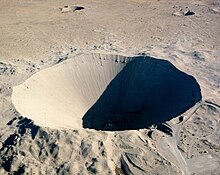
Back Кратер от взрив Bulgarian Cràter d'explosió Catalan Explosionskrater German Cráter de explosión Spanish Leherketa-krater Basque Cratère d'explosion French 爆裂火口 Japanese აფეთქებითი კრატერი Georgian Eksplosjonskrater NN Взрывная воронка Russian


An explosion crater is a type of crater formed when material is ejected from the surface of the ground by an explosion at or immediately above or below the surface.

A crater is formed by an explosion through the displacement and ejection of material from the ground. It is typically bowl-shaped. High-pressure gas and shock waves cause three processes responsible for the creation of the crater:
- Plastic deformation of the ground.
- Projection of material (ejecta) from the ground by the explosion.
- Spallation of the ground surface.
Two processes partially fill the crater back in:
- Fall-back of ejecta.
- Erosion and landslides of the crater lip and wall.[1]
The relative importance of the five processes varies, depending on the height above or depth below the ground surface at which the explosion occurs and on the composition of the ground.
- ^ P. W. Cooper. Explosives Engineering. Wiley-VCH. ISBN 0-471-18636-8